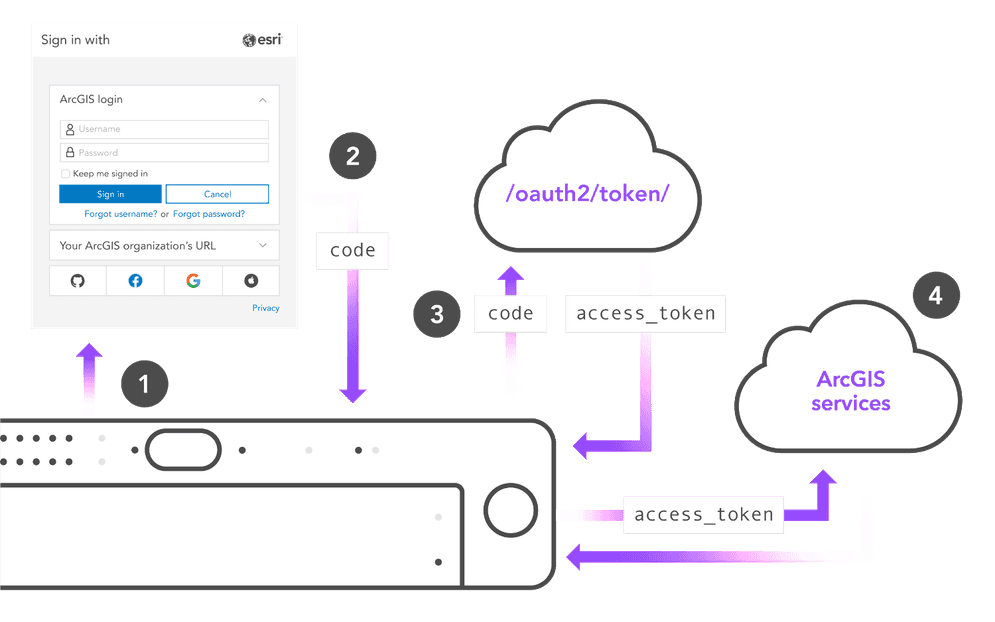The Authorization code flow is an OAuth 2.0 authorization method used to implement user authentication in applications with a server-side component. This page provides an overview of the flow and explains how to implement it.
This is the recommended authentication flow for user authentication in applications with a server-side component.

The Authorization code flow is an OAuth 2.0 workflow commonly used in apps with a server-side component. Authorization occurs in two steps, with the app first requesting an authorization code from the authorization endpoint. The authorization code is then sent to the token endpoint to request an access token.
The general steps of how the Authorization code flow works are:
-
Application sends a request to the authorization endpoint that includes a
clientand_id redirectfrom OAuth credentials._uri -
The application user signs in with an ArcGIS account. The authorization endpoint verifies the user's identity and returns an authorization code.
-
Application uses the resulting
authorizationas well as the_code clientand_id redirectfrom OAuth credentials, to submit a request to the token endpoint. The token endpoint verifies the authorization code and issues an access token._uri -
Client uses the access token to authorize requests to secure resources.
Manual implementation
The remainder of this page shows how to manually implement user authentication without using an ArcGIS API or Maps SDK. Instead, authentication is implemented by directly making HTTP requests to the proper REST API endpoints.
This sample is written in JavaScript, but can be implemented in any language. It adheres to the OAuth 2.0 specification for the Authorization code flow.
Create OAuth credentials
User authentication requires a set of OAuth credentials.
The steps to create OAuth credentials with an ArcGIS Location Platform account are:
-
Sign in to your ArcGIS portal.
-
Click Content > My content > New item and select Developer credentials.
-
In the Credential types menu, select OAuth credentials.
-
Add a redirect URL and click Next.
-
In the Privileges and Grant item access menus, click Next; these are not required for user authentication.
-
Name the credentials and click Next to review. When you are ready to create the credentials, click Create.
Configure authentication variables
-
Copy your client ID and chosen redirect URL from your OAuth credentials and include them in your app.
index.htmlUse dark colors for code blocks const clientId = '<YOUR_CLIENT_ID>'; const redirectUri = '<YOUR_REDIRECT_URL>'; let session = null; let map = null; const signInButton = document.getElementById('sign-in'); const signOutButton = document.getElementById('sign-out');
Request an authorization code
-
Format a GET request to the authorization endpoint. Include your
clientand_id redirect._uri index.htmlUse dark colors for code blocks const authorizationEndpoint = 'https://www.arcgis.com/sharing/rest/oauth2/authorize'+ '?client_id=' + clientId + '&redirect_uri=' + window.encodeURIComponent(redirectUri)+ '&response_type=code'+ '&expiration=20160'; -
When the user clicks 'sign in', open the authorization endpoint in a new window.
index.htmlUse dark colors for code blocks const authorizationEndpoint = 'https://www.arcgis.com/sharing/rest/oauth2/authorize'+ '?client_id=' + clientId + '&redirect_uri=' + window.encodeURIComponent(redirectUri)+ '&response_type=code'+ '&expiration=20160'; signInButton.addEventListener('click', () => window.open(authorizationEndpoint, 'oauth-window', 'height=400,width=600,menubar=no,location=yes,resizable=yes,scrollbars=yes,status=yes'));
Create a callback
-
Create a callback function in
index.htmlthat will receive the authorization code.index.htmlUse dark colors for code blocks const oauthCallback = (authorizationCode) => { } window.oauthCallback = oauthCallback; //required due to the module scope of this script -
Create a new HTML page at the location of your redirect URI. When a user successfully authenticates at the authorization endpoint, they will be redirected to this page.
callback.htmlUse dark colors for code blocks <!DOCTYPE html> <head> <title>ArcGIS user authentication OAuth 2.0 callback (vanilla JS)</title> </head> <body> <script type="module"> </script> </body> </html> -
Access the authorization code returned from the endpoint. It is found in the
searchparameter of the URL. Pass the code to the callback function created inindex.html.callback.htmlUse dark colors for code blocks <!DOCTYPE html> <head> <title>ArcGIS user authentication OAuth 2.0 callback (vanilla JS)</title> </head> <body> <script type="module"> const match = (window.location.search) ? window.location.search.match(/\?code=([^&]+)/) : false; // if we found an authorization code in the URL, pass the token up to a global function in index.html if(match[1]) { window.opener.oauthCallback(match[1]); } window.close(); </script> </body> </html>
Request an access token
-
Find the URL of the token endpoint for your ArcGIS organization. For ArcGIS Online users, the token endpoint is
https.://www.arcgis.com/sharing/rest/oauth2/token index.htmlUse dark colors for code blocks const oauthCallback = (authorizationCode) => { const tokenEndpoint = 'https://www.arcgis.com/sharing/rest/oauth2/token'; } window.oauthCallback = oauthCallback; //required due to the module scope of this script -
Submit an HTTP request to the token endpoint to request an access token. Include your
authorization,_code client, and_id redirectto create a valid request, and set the_uri grantas_type authorization._code index.htmlUse dark colors for code blocks const oauthCallback = (authorizationCode) => { const tokenEndpoint = 'https://www.arcgis.com/sharing/rest/oauth2/token'; fetch(tokenEndpoint, { method:'POST', body: JSON.stringify({ client_id:clientId, grant_type:'authorization_code', code:authorizationCode, redirect_uri:redirectUri }), headers: { "Content-type": "application/json; charset=UTF-8" } }) } window.oauthCallback = oauthCallback; //required due to the module scope of this script -
Access the response from the endpoint. If the request was valid, the response will contain an
access,_token refresh,_token username, and other session information.index.htmlUse dark colors for code blocks const oauthCallback = (authorizationCode) => { const tokenEndpoint = 'https://www.arcgis.com/sharing/rest/oauth2/token'; fetch(tokenEndpoint, { method:'POST', body: JSON.stringify({ client_id:clientId, grant_type:'authorization_code', code:authorizationCode, redirect_uri:redirectUri }), headers: { "Content-type": "application/json; charset=UTF-8" } }) .then(response => response.json()).then(newSession => { updateSession(newSession); initApp(newSession); }) } window.oauthCallback = oauthCallback; //required due to the module scope of this script
Serialize session info
-
Serialize the session information from the token endpoint and add it to local storage to make the session persistent across page refreshes.
index.htmlUse dark colors for code blocks Copy const updateSession = (sessionInfo) => { const userInfo = document.getElementById('user-info'); if (!sessionInfo) { localStorage.removeItem("__ARCGIS_USER_SESSION__"); session = null; destroyApp(); // signed out sidebar state userInfo.classList.add('hide'); userInfo.innerHTML = ``; signOutButton.classList.add('hide'); signInButton.classList.remove('hide'); } else { session = sessionInfo; localStorage.setItem("__ARCGIS_USER_SESSION__", JSON.stringify(session)); // signed in sidebar state userInfo.classList.remove('hide'); userInfo.innerHTML = `Welcome, ${sessionInfo.username}.`; signOutButton.classList.remove('hide'); signInButton.classList.add('hide'); } }